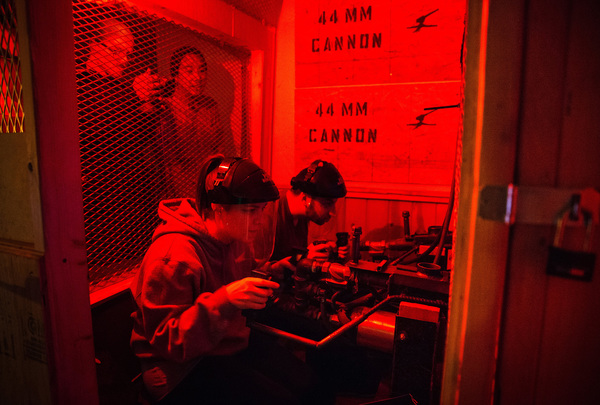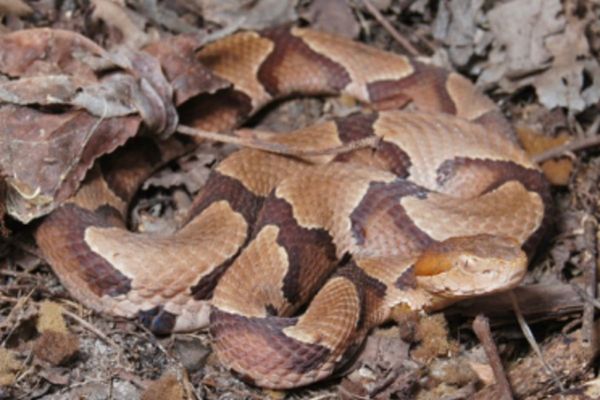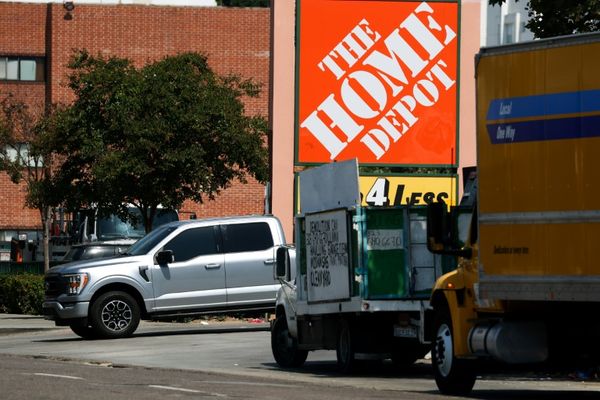
SEATTLE _ One recent Saturday evening, Zach Vandiver crawled on his belly through a small, dark, fog-filled room with red laser beams slicing the air. If his body touched one of the beams, an alarm would sound. He'd be busted.
It looked like he was trying to steal the crown jewels or working as a stunt double in a scene from "Mission Impossible." The clue that he wasn't: Vandiver crawled with a golf putter in one hand.
"Watch your butt! Watch your butt!" one of his competitors shouted. Vandiver immediately lowered his posterior, just below one of the red lasers above his waist, and kept crawling. He stood up, found his golf ball through the stage-fog gloom and took his putt. He made par. Once he crawled back beneath the lasers to his group, he was jubilant. "This is so, so cool," he enthused. "I live on Beacon Hill and I've never heard of this before _ it's probably one of the best-kept secrets in Seattle!"

Vandiver had discovered Smash Putt, the "miniature golf apocalypse" nightclub that's been popping up for ephemeral installments in otherwise-unused spaces around Seattle since 2009: a former candy factory on Capitol Hill, a former Immigration and Naturalization Service building in the International District, and now a former Mexican restaurant near Pike Place Market.
He found it none too soon.
After seven years of sawing, soldering and dreaming up new putt-putt challenges, this is Smash Putt's final shot.

"Our mission is to make the world weirder," Smash Putt co-founder Jeremy Franklin-Ross said over the din near Smash Putt's bar. With Smash Putt, he said, "I think we've fulfilled it."
The organizers haven't set a firm closing date _ by its nature, Smash Putt is a mayfly that pops up and disappears unpredictably _ but Franklin-Ross says people can check it out "through sometime in April."
Designed and built by hackers of both analog and digital persuasions, from woodworkers to software programmers, Smash Putt is a gleeful marriage between Seattle's old-school scrappy grit and its glimmery, high-rise tech culture.

But Smash Putt is for everyone.
Or, at least, anyone who thinks it'd be fun to spend an evening crawling around lasers in the dark; making a cacophony by shooting golf balls out of pneumatic cannons onto clanging circular-saw blades and propane tanks; finding hidden doors; playing a bigger-than-life-sized game of Operation (where putters have to extract golf balls from holes with gigantic tweezers); composing music by placing balls into a rotating turntable with divots, which is hooked up to drums and a guitar; or solving the mystery of a tragic romance in a 1984-era basement before putting a ball into a cat's litter box.
If that all sounds overwhelming and confusing _ well, that's the point.

Smash Putt might be the most delightfully psychedelic and disorienting game of miniature golf ever created.
Strange fun, social experiment Franklin-Ross first hit on the idea for Smash Putt after a road trip in the early 2000s to Massachusetts, when he visited a friend who was part of a mini-golf league. The rules of her club dictated that if a player saw certain putt-putt cliches (a dinosaur, a water feature), she had to get as close to it as possible and smoke pot.
"I don't smoke pot," Franklin-Ross said, "so, waiting for her to light up, I had a lot of time to think about the construct of miniature golf. As a child, I found miniature golf disappointing. There's a windmill, there's a dinosaur, but you can't touch any of it! It was boring."

So, on his long drive back to the West Coast, Franklin-Ross dreamed up a new idea: putt-putt for weirdos.
Behind the racket of any given night at Smash Putt _ music, people shouting at each other, pneumatic gadgets whirling and clanging _ there are two principles at work.
On one hand, Smash Putt is just strange fun. On the other, Franklin-Ross and Smash Putt co-conspirator James Guerci explained _ while two young women nearby tried to figure out how to get a golf ball out of a miniature water wheel _ it's a kind of social experiment in cooperation versus competition.

Franklin-Ross brought up one example: the "Roulette Francais," from one of Smash Putt's original incarnations. One player would try to putt into the hole, across a spinning, circular green, but the spinning was controlled by a competitor mounted on a stationary motor scooter.
"That really made you choose whether you're going to be cooperative or competitive," he said. The opponent "has to choose how fast it goes, whether you're going to shine the headlight on someone while blaring the horn _ or you could play nice and make it spin slow and steady."
The game, Guerci added, also allows people to experiment with the world around them _ and he hopes people will take that experience beyond Smash Putt's doors and be more innovative in their own lives.

"The built environment around us is only how you imagine it," he said, kicking a nearby plywood box with his boot, "You can use it however you want."
And Smash Putt wants you to play.
Other Smash Putt experiments have been more abstract and absurd. The "Roulette Rusky," in one of their Portland pop-ups, was, as Franklin-Ross put it, "a very dark and abstract poem we wrote." There was a flickering overhead light, gore on the walls, spent gun cartridges on the floor _ and no hole to putt into. Players, he said, would get frustrated and "break everything, beat the lights out. People reacted very oddly." Once the Smash Putt crew drilled a hole into the floor for people to play, the vandalism stopped.

Overall, Franklin-Ross said, Smash Putt's social experiment has produced "bombastic, joyful arguments that fill the room" but the spirit of cooperation makes for "sweet moments between people amid a world of chaos."
"Designed to go away"Smash Putt was always meant to be a disappearing act.
Unlike more traditional art projects, Guerci said, "this one is designed to go away _ eventually, it's all going out to the dumpster. This art is ephemeral."

But the Smash Putt crew (which informally calls itself the Department of Culture) isn't disbanding. It is, Franklin-Ross said, brainstorming about more intimate projects than a nightclub, "things that are more targeted, to take people on smaller adventures."
As an example, he cited a pre-Smash-Putt project he worked on with choreographer and dancer Jessie Smith of Dead Bird Movement and now-defunct Seattle performance group Implied Violence: "We ran an illegal art-taxi service with VW Beetles that had ��not-a-taxi' signs on them. The rule was that if somebody hailed you, you had to pick them up, and you had to refuse payment, but you didn't necessarily have to take them where they wanted to go."
Weren't the hailers angry when they realized they weren't in a taxi, but had been lured into performance art?
"No, no," Franklin-Ross said. "I had blue hair at the time and Jessie was bedecked with tattoos and we had the 'not-a-taxi' signs." If somebody saw the car pull up with its drivers and didn't want to join in, they typically opted out. People who got into the not-a-taxi were typically game for an unexpected thrill.
That's the kind of project, Franklin-Ross said, that the world needs more of.







